Kede Ma
Bi-Level Optimization for Self-Supervised AI-Generated Face Detection
Jul 30, 2025



Abstract:AI-generated face detectors trained via supervised learning typically rely on synthesized images from specific generators, limiting their generalization to emerging generative techniques. To overcome this limitation, we introduce a self-supervised method based on bi-level optimization. In the inner loop, we pretrain a vision encoder only on photographic face images using a set of linearly weighted pretext tasks: classification of categorical exchangeable image file format (EXIF) tags, ranking of ordinal EXIF tags, and detection of artificial face manipulations. The outer loop then optimizes the relative weights of these pretext tasks to enhance the coarse-grained detection of manipulated faces, serving as a proxy task for identifying AI-generated faces. In doing so, it aligns self-supervised learning more closely with the ultimate goal of AI-generated face detection. Once pretrained, the encoder remains fixed, and AI-generated faces are detected either as anomalies under a Gaussian mixture model fitted to photographic face features or by a lightweight two-layer perceptron serving as a binary classifier. Extensive experiments demonstrate that our detectors significantly outperform existing approaches in both one-class and binary classification settings, exhibiting strong generalization to unseen generators.
Dataset Distillation as Data Compression: A Rate-Utility Perspective
Jul 23, 2025Abstract:Driven by the ``scale-is-everything'' paradigm, modern machine learning increasingly demands ever-larger datasets and models, yielding prohibitive computational and storage requirements. Dataset distillation mitigates this by compressing an original dataset into a small set of synthetic samples, while preserving its full utility. Yet, existing methods either maximize performance under fixed storage budgets or pursue suitable synthetic data representations for redundancy removal, without jointly optimizing both objectives. In this work, we propose a joint rate-utility optimization method for dataset distillation. We parameterize synthetic samples as optimizable latent codes decoded by extremely lightweight networks. We estimate the Shannon entropy of quantized latents as the rate measure and plug any existing distillation loss as the utility measure, trading them off via a Lagrange multiplier. To enable fair, cross-method comparisons, we introduce bits per class (bpc), a precise storage metric that accounts for sample, label, and decoder parameter costs. On CIFAR-10, CIFAR-100, and ImageNet-128, our method achieves up to $170\times$ greater compression than standard distillation at comparable accuracy. Across diverse bpc budgets, distillation losses, and backbone architectures, our approach consistently establishes better rate-utility trade-offs.
Come Together, But Not Right Now: A Progressive Strategy to Boost Low-Rank Adaptation
Jun 06, 2025Abstract:Low-rank adaptation (LoRA) has emerged as a leading parameter-efficient fine-tuning technique for adapting large foundation models, yet it often locks adapters into suboptimal minima near their initialization. This hampers model generalization and limits downstream operators such as adapter merging and pruning. Here, we propose CoTo, a progressive training strategy that gradually increases adapters' activation probability over the course of fine-tuning. By stochastically deactivating adapters, CoTo encourages more balanced optimization and broader exploration of the loss landscape. We provide a theoretical analysis showing that CoTo promotes layer-wise dropout stability and linear mode connectivity, and we adopt a cooperative-game approach to quantify each adapter's marginal contribution. Extensive experiments demonstrate that CoTo consistently boosts single-task performance, enhances multi-task merging accuracy, improves pruning robustness, and reduces training overhead, all while remaining compatible with diverse LoRA variants. Code is available at https://github.com/zwebzone/coto.
VisualQuality-R1: Reasoning-Induced Image Quality Assessment via Reinforcement Learning to Rank
May 20, 2025



Abstract:DeepSeek-R1 has demonstrated remarkable effectiveness in incentivizing reasoning and generalization capabilities of large language models (LLMs) through reinforcement learning. Nevertheless, the potential of reasoning-induced computational modeling has not been thoroughly explored in the context of image quality assessment (IQA), a task critically dependent on visual reasoning. In this paper, we introduce VisualQuality-R1, a reasoning-induced no-reference IQA (NR-IQA) model, and we train it with reinforcement learning to rank, a learning algorithm tailored to the intrinsically relative nature of visual quality. Specifically, for a pair of images, we employ group relative policy optimization to generate multiple quality scores for each image. These estimates are then used to compute comparative probabilities of one image having higher quality than the other under the Thurstone model. Rewards for each quality estimate are defined using continuous fidelity measures rather than discretized binary labels. Extensive experiments show that the proposed VisualQuality-R1 consistently outperforms discriminative deep learning-based NR-IQA models as well as a recent reasoning-induced quality regression method. Moreover, VisualQuality-R1 is capable of generating contextually rich, human-aligned quality descriptions, and supports multi-dataset training without requiring perceptual scale realignment. These features make VisualQuality-R1 especially well-suited for reliably measuring progress in a wide range of image processing tasks like super-resolution and image generation.
NTIRE 2025 Challenge on Real-World Face Restoration: Methods and Results
Apr 20, 2025Abstract:This paper provides a review of the NTIRE 2025 challenge on real-world face restoration, highlighting the proposed solutions and the resulting outcomes. The challenge focuses on generating natural, realistic outputs while maintaining identity consistency. Its goal is to advance state-of-the-art solutions for perceptual quality and realism, without imposing constraints on computational resources or training data. The track of the challenge evaluates performance using a weighted image quality assessment (IQA) score and employs the AdaFace model as an identity checker. The competition attracted 141 registrants, with 13 teams submitting valid models, and ultimately, 10 teams achieved a valid score in the final ranking. This collaborative effort advances the performance of real-world face restoration while offering an in-depth overview of the latest trends in the field.
Toward Generalized Image Quality Assessment: Relaxing the Perfect Reference Quality Assumption
Mar 14, 2025



Abstract:Full-reference image quality assessment (FR-IQA) generally assumes that reference images are of perfect quality. However, this assumption is flawed due to the sensor and optical limitations of modern imaging systems. Moreover, recent generative enhancement methods are capable of producing images of higher quality than their original. All of these challenge the effectiveness and applicability of current FR-IQA models. To relax the assumption of perfect reference image quality, we build a large-scale IQA database, namely DiffIQA, containing approximately 180,000 images generated by a diffusion-based image enhancer with adjustable hyper-parameters. Each image is annotated by human subjects as either worse, similar, or better quality compared to its reference. Building on this, we present a generalized FR-IQA model, namely Adaptive Fidelity-Naturalness Evaluator (A-FINE), to accurately assess and adaptively combine the fidelity and naturalness of a test image. A-FINE aligns well with standard FR-IQA when the reference image is much more natural than the test image. We demonstrate by extensive experiments that A-FINE surpasses standard FR-IQA models on well-established IQA datasets and our newly created DiffIQA. To further validate A-FINE, we additionally construct a super-resolution IQA benchmark (SRIQA-Bench), encompassing test images derived from ten state-of-the-art SR methods with reliable human quality annotations. Tests on SRIQA-Bench re-affirm the advantages of A-FINE. The code and dataset are available at https://tianhewu.github.io/A-FINE-page.github.io/.
CLDyB: Towards Dynamic Benchmarking for Continual Learning with Pre-trained Models
Mar 06, 2025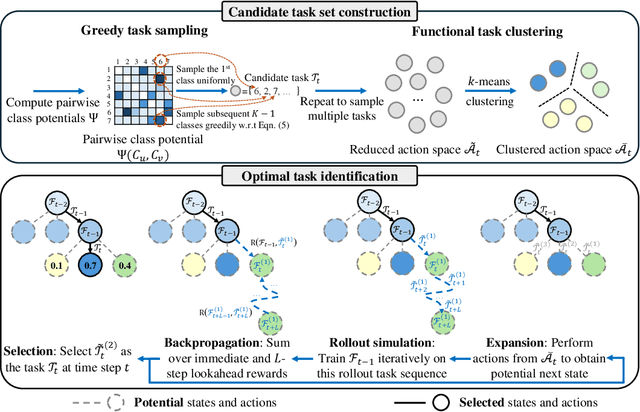



Abstract:The advent of the foundation model era has sparked significant research interest in leveraging pre-trained representations for continual learning (CL), yielding a series of top-performing CL methods on standard evaluation benchmarks. Nonetheless, there are growing concerns regarding potential data contamination during the pre-training stage. Furthermore, standard evaluation benchmarks, which are typically static, fail to capture the complexities of real-world CL scenarios, resulting in saturated performance. To address these issues, we describe CL on dynamic benchmarks (CLDyB), a general computational framework based on Markov decision processes for evaluating CL methods reliably. CLDyB dynamically identifies inherently difficult and algorithm-dependent tasks for the given CL methods, and determines challenging task orders using Monte Carlo tree search. Leveraging CLDyB, we first conduct a joint evaluation of multiple state-of-the-art CL methods, leading to a set of commonly challenging and generalizable task sequences where existing CL methods tend to perform poorly. We then conduct separate evaluations of individual CL methods using CLDyB, discovering their respective strengths and weaknesses. The source code and generated task sequences are publicly accessible at https://github.com/szc12153/CLDyB.
Self-Supervised Learning for Detecting AI-Generated Faces as Anomalies
Jan 04, 2025



Abstract:The detection of AI-generated faces is commonly approached as a binary classification task. Nevertheless, the resulting detectors frequently struggle to adapt to novel AI face generators, which evolve rapidly. In this paper, we describe an anomaly detection method for AI-generated faces by leveraging self-supervised learning of camera-intrinsic and face-specific features purely from photographic face images. The success of our method lies in designing a pretext task that trains a feature extractor to rank four ordinal exchangeable image file format (EXIF) tags and classify artificially manipulated face images. Subsequently, we model the learned feature distribution of photographic face images using a Gaussian mixture model. Faces with low likelihoods are flagged as AI-generated. Both quantitative and qualitative experiments validate the effectiveness of our method. Our code is available at \url{https://github.com/MZMMSEC/AIGFD_EXIF.git}.
Learning Where to Edit Vision Transformers
Nov 04, 2024



Abstract:Model editing aims to data-efficiently correct predictive errors of large pre-trained models while ensuring generalization to neighboring failures and locality to minimize unintended effects on unrelated examples. While significant progress has been made in editing Transformer-based large language models, effective strategies for editing vision Transformers (ViTs) in computer vision remain largely untapped. In this paper, we take initial steps towards correcting predictive errors of ViTs, particularly those arising from subpopulation shifts. Taking a locate-then-edit approach, we first address the where-to-edit challenge by meta-learning a hypernetwork on CutMix-augmented data generated for editing reliability. This trained hypernetwork produces generalizable binary masks that identify a sparse subset of structured model parameters, responsive to real-world failure samples. Afterward, we solve the how-to-edit problem by simply fine-tuning the identified parameters using a variant of gradient descent to achieve successful edits. To validate our method, we construct an editing benchmark that introduces subpopulation shifts towards natural underrepresented images and AI-generated images, thereby revealing the limitations of pre-trained ViTs for object recognition. Our approach not only achieves superior performance on the proposed benchmark but also allows for adjustable trade-offs between generalization and locality. Our code is available at https://github.com/hustyyq/Where-to-Edit.
Semantics-Oriented Multitask Learning for DeepFake Detection: A Joint Embedding Approach
Aug 29, 2024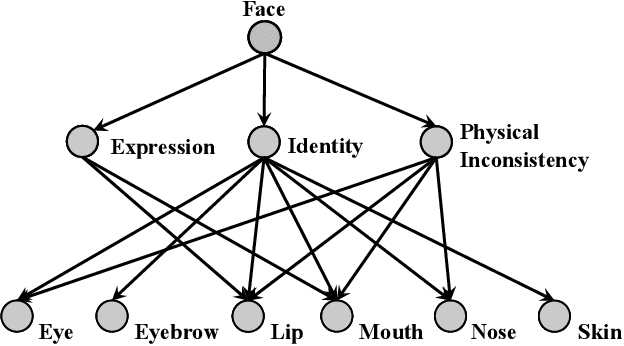
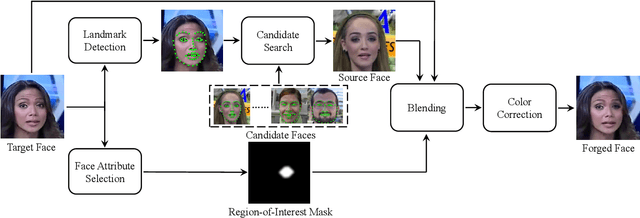
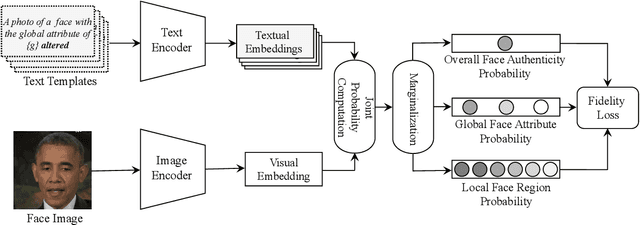
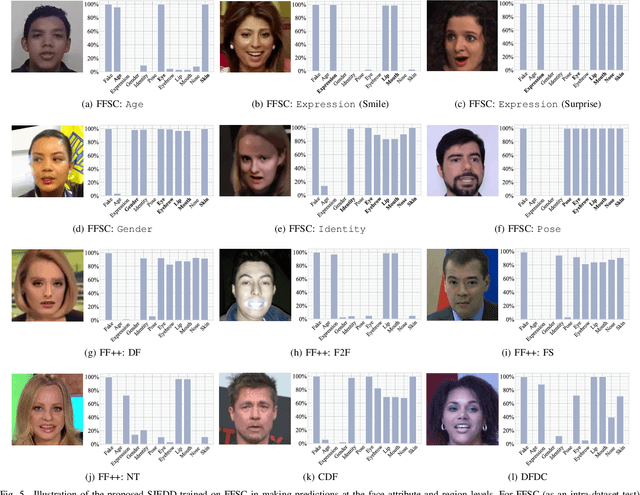
Abstract:In recent years, the multimedia forensics and security community has seen remarkable progress in multitask learning for DeepFake (i.e., face forgery) detection. The prevailing strategy has been to frame DeepFake detection as a binary classification problem augmented by manipulation-oriented auxiliary tasks. This strategy focuses on learning features specific to face manipulations, which exhibit limited generalizability. In this paper, we delve deeper into semantics-oriented multitask learning for DeepFake detection, leveraging the relationships among face semantics via joint embedding. We first propose an automatic dataset expansion technique that broadens current face forgery datasets to support semantics-oriented DeepFake detection tasks at both the global face attribute and local face region levels. Furthermore, we resort to joint embedding of face images and their corresponding labels (depicted by textual descriptions) for prediction. This approach eliminates the need for manually setting task-agnostic and task-specific parameters typically required when predicting labels directly from images. In addition, we employ a bi-level optimization strategy to dynamically balance the fidelity loss weightings of various tasks, making the training process fully automated. Extensive experiments on six DeepFake datasets show that our method improves the generalizability of DeepFake detection and, meanwhile, renders some degree of model interpretation by providing human-understandable explanations.
 Add to Chrome
Add to Chrome Add to Firefox
Add to Firefox Add to Edge
Add to Edge